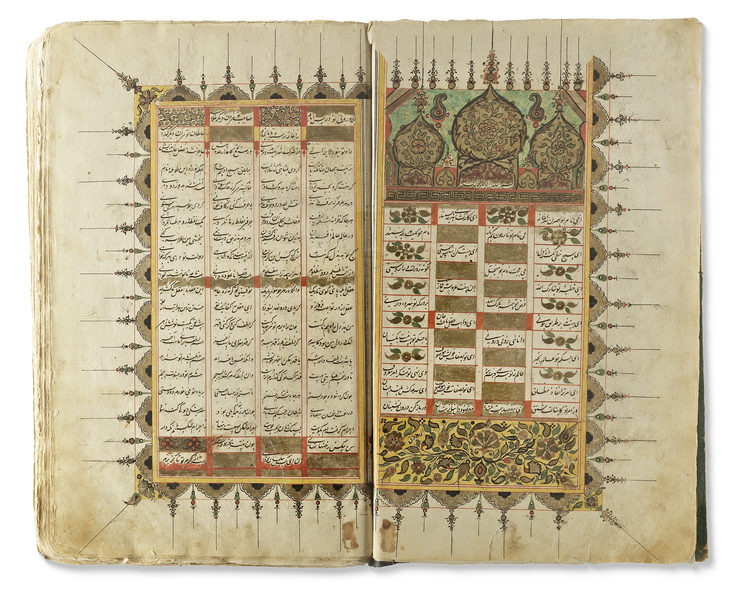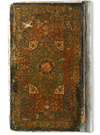Lot 207 NIZAMI (D.1209), KHAMSA , COPIED BY IBN MUHAMMED SHAFI' KHATALANI, PERSIA AND DATED 1204 AH/1789 AD
Persian manuscript on paper, 21 lines per page, written in neat black nasta'liq script, arranged in four gold and polychrome-outlined columns. Titles are in red, blue, and gold, with polychrome illuminated title pages. The manuscript contains 66 paintings and five polychrome and gold headings. The last page is signed: "Written by Ibn Muhammad Shafi'" and dated 1204 AH. In gilt enameled Qajar binding. Dimensions: 21 by 34 cm
Catalogue Note: The manuscript opens with Layla and Majnun, followed by the Makhzan al-Asrar (The Treasury or Storehouse of Mysteries), Haft Paykar (The Seven Beauties), and the Iskandarnameh, divided into the Sharafnama and the Iqbalnama. The manuscript has been occasionally misbound, as the order of the chapters does not follow the original narrative sequence.
From Layla and Majnun: Taking Majnun's father to the Kaaba, Majnun brought in chains to Layla's tent, Majnun in the wilderness with the animals, Majnun kneeling by Layla's tent.
The Makhzan al-Asrar
From the Haft Paykar: Battle scenes, Bahram Gur with the Chinese Princess in the Yellow Pavilion, Bahram Gur with the Khwarazm Princess in the Green Pavilion, Bahram Gur with his wives, Bahram Gur in hunting scenes.
From the Iskandarnameh: In two parts: Sharafnama (The Book of Glory) followed by Iqbalnama (The Book of Fortune).
Catalogue note:
Nizami Ganjavi (c. 1141–1209)
This celebrated quintet of Persian narrative poems—known as the Khamsa (“Five Treasures”)—represents the pinnacle of medieval Persian literary and artistic achievement. Composed in elegant rhyming couplets, Nizami’s Khamsa became a foundational model for later poets and a favored subject for richly illustrated manuscripts across the Persianate world.
Makhzan al-Asrar (The Treasury of Mysteries): A didactic, mystical work of moral reflections and Sufi-inflected allegories.
Khusraw and Shirin: A romantic epic recounting the love of the Sasanian king Khusraw II for the spirited Armenian princess Shirin.
Layla and Majnun: A poignant tale of unfulfilled, spiritual love, where passion leads to divine madness.
Haft Paykar (The Seven Beauties): A cosmological romance: King Bahram Gur visits seven pavilions, each linked to a day of the week, color, and planetary deity, hearing a tale from each princess.
Iskandarnameh (The Book of Alexander): A two-part philosophical epic—Sharafnameh and Iqbalnameh—depicting Alexander the Great as conqueror, seeker of wisdom, and prophet-king.












